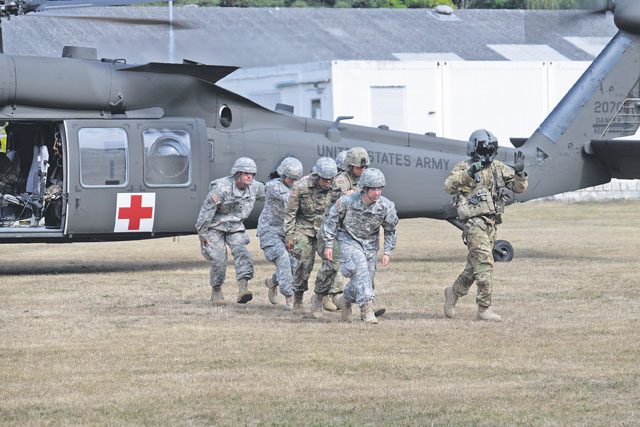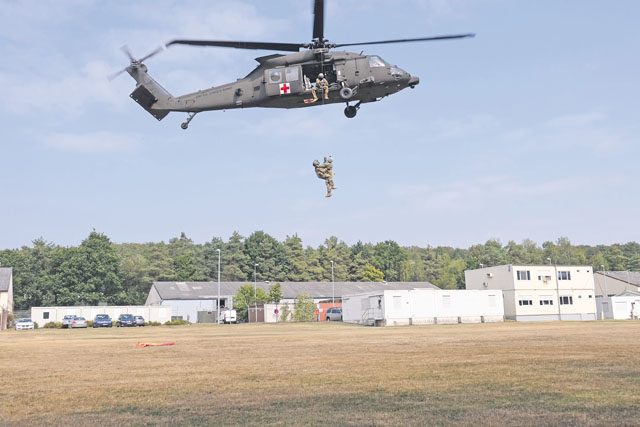
Army Reserve medics and active duty helicopter pilots worked together to practice loading and transporting patients.
Seventh Mission Support Command Soldiers from the Medical Support Unit-Europe conducted medical evacuation orientation and training with the 1st Armored Division’s Combat Aviation Brigade Sept. 9 at NCO Field on Daenner Kaserne.
The training was designed to improve efficiency and create realistic training and familiarization with the safe use of Army MEDEVAC UH-60 Blackhawk helicopters during the MSU-E’s annual training exercise.
“Today we had an aviation MEDEVAC unit come down and we basically practiced the interaction, the handoff techniques,” said 1st Lt. Daniel Clark, an operations officer with the MSU-E, 7th MSC.
In the morning there was an aircrew safety orientation and familiarization brief to the MSU-E Soldiers followed by cold-load training.
“It was great,” said Staff Sgt. Jessie Turner, flight medic with the 1st Armored Division’s Combat Aviation Brigade. “I feel like we reinforced skills that we both had.”
The afternoon session was more intense with hot-load litter training, hoist operations with short flights above and around the NCO Parade Field or landing zone. This allowed the MSU-E Soldiers to understand how to keep future patients stable during on-load and off-load from a MEDEVAC helicopter.
Turner said they trained with specialized litters, which are used to load patients into their aircraft when they are unable to land due to the terrain.
Clark said it was important for his Soldiers to know what to expect when a MEDEVAC helicopter arrives, including how to approach the helicopters, how to load patients on and how to interact with their crew chief and flight medic, in order to do ground handoffs and ensure everything runs correctly in real-life scenarios.
“Our medics were really excited to work with a flight medic and learn the other side of being a medic,” Clark said.
“Today we practiced a few techniques incorporating a Blackhawk helicopter platform,” said Spc. John Duncan, a medic with the MSU-E, 7th MSC. “First of which was loading a patient onto a litter, and the second of which was actually loading a litter onto the helicopter.”
After that, the training involved hoist operations during which members of the crew dropped from the helicopter and picked up a simulated casualty from the ground, he said.
“It was very exciting,” Duncan said. “I think it gave a lot of insight into how the operation typically works and what some of our capabilities are with that platform as well.”
According to Duncan, a major concern for medics when transporting patients is not causing further damage and understanding what happens in the last phase of care when transporting somebody.
The training gave some insight into how patients are transported and how they are loaded, Duncan said. It also gave the medics some considerations as they hand patients off to the flight crew.
“It was a good review of our Soldier skills, some of our basic Soldier skills, such as radio operation and then the liter carries,” Duncan said. “It tied everything together into a more cohesive, real training exercise.
Duncan said the training is more effective when one visualizes what’s happening and incorporates it into a more realistic setting.
“It was great training,” Turner said. “I appreciate everyone that was here and hope to do it again sometime.”



